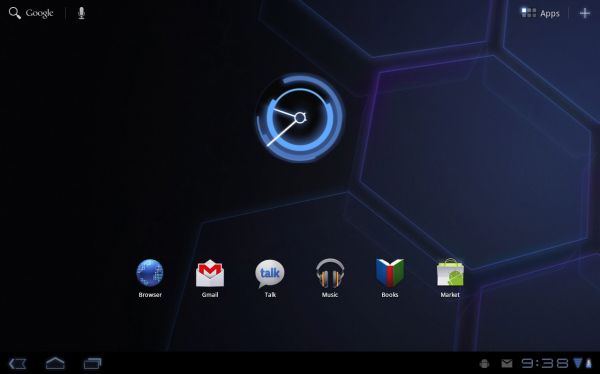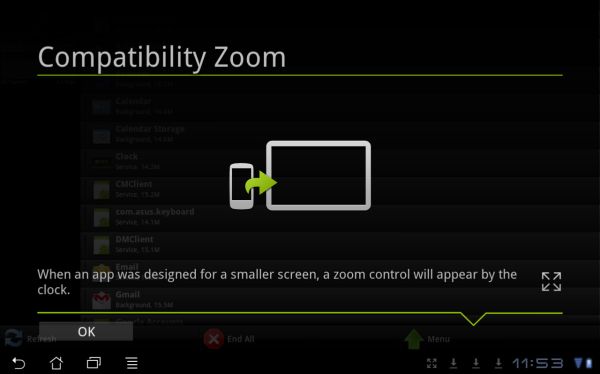Toshiba Thrive: Honeycomb Hits $300
by Vivek Gowri on December 12, 2011 3:00 AM ESTThe Thrive was recently updated to Honeycomb 3.2, giving it a nice boost in GPU performance as well as the ability to scale apps to fit the larger screen. And the overall experience is pretty much as you’d expect from a 10” tablet running Tegra 2 and Honeycomb; there’s been so many tablets in the last 10 months that follow that formula that by now there’s nothing too surprising about it.
Toshiba’s install of Honeycomb is pretty clean, with no changes to the UI and a decent set of preinstalled software on hand. Toshiba’s own applications include an e-reader app called BookPlace, an app store called AppPlace, a file manager, a media player, and a software/firmware update manager. Third-party applications included paid apps like QuickOffice, Kapersky Tablet Security, LogMeIn Ignition, PrinterShare, and Need for Speed Shift, as well as the free Google App suite (Gmail, Google Talk, Calendar, Maps, Navigation, etc) and some assorted games like solitaire, backgammon, and spades. I was pretty pleased, as most of the included apps were pretty useful, though some of the games and the secondary application store I could have done without.
Honeycomb has done a lot of maturing in the last year, so it’s finally a stable platform with a functioning app store. The compatibility zoom feature is pretty helpful in expanding the selection of usable applications. But there are still some rough edges that we’d like to see fixed, especially in the smoothness and overall polish of the OS. Ice Cream Sandwich is supposed to fix the minor things and give it an overall more consistent UI, though we’ll see how successfully it can do that. It is expected that Toshiba will provide the upgrade path to Ice Cream Sandwich in January or February of next year, so users buying now won’t get screwed. If not, there’s always the CyanogenMod crew to turn to for the upgrade to 4.0.












33 Comments
View All Comments
doggod - Monday, December 12, 2011 - link
How is what Microsoft wants, come into the net books argument at all. None of the tablets people are buying come with a Microsoft OS so you would imagine that manufactures would jump on having net books with android installed which negates any licensing costs.Personally I dont get their use either, apart as a toy. And an expensive toy.
Portability is negated by having to type on the screen( which if you haven't left the tablet down on a surface you have to do one handed)
Websites have to be zoomed to read properly
mathew7 - Tuesday, December 13, 2011 - link
"How is what Microsoft wants, come into the net books argument at all. None of the tablets people are buying come with a Microsoft OS so you would imagine that manufactures would jump on having net books with android installed which negates any licensing costs."Please research before you talk. Just a hint: tablets are not sold with Windows because there is no way to run it. The CPU from the tablets has nothing in common with what you have on a netbook or desktop. It's like diesel vs. gasoline engine: they both take you somewhere, but how they make power is completely different (you cannot run and/or you will damage either engine if you put the wrong fuel).
So tablet designers take no attention to MS Win Starter limitations. But netbook designers, even if the tablet will be sold with Win7 HP, it's still designed for Win7 Starter because of HW sharing between models.
DanNeely - Monday, December 12, 2011 - link
Viewing angles? IPS vs TN?Hrel - Monday, December 12, 2011 - link
I can't beleive someone who reads anandtech has to ask this. TN maxes out at about 170 degree viewing angles, marketed, not practical application. IPS is basically 180 degree, ie you can always see it and it always looks good. IPS has significantly longer response times though. Pretty much all flat panel LCD tv's are IPS.Aloonatic - Monday, December 12, 2011 - link
Why bother to read anandtech at all, when you know everything already?mjcutri - Monday, December 12, 2011 - link
I made the mistake of buying a Thrive for my wife when they first came out in July. It was one of my worst tech purchases ever. I liked the idea of the dock and full size ports, but the flaws just don't make up for what I perceived as advantages.The screen takes next to nothing to break it and Toshiba knows it. They charge over $300 to replace it. Initially you could get a replacement screen and spend 4 hours trying to fix it yourself, but there was such a run on them (since the screen is so crappy) that they ran out of stock quickly. Since then, they have increased the price from $80 to $160 for the replacement screen, which now isn't worth it.
I'm getting her a Transformer when the price drops on those.
mjcutri - Monday, December 12, 2011 - link
Oh yeah, I forgot to mention the incredibly buggy software.The well known problem of not waking from sleep has still not been fixed. (You have to turn it completely off and then back on again.) The screen randomly turn on by itself. (which is really annoying when you're trying to sleep.) The screen randomly doesn't go to sleep when you press the power button. (It just flashes black and then back on again.)
VivekGowri - Monday, December 12, 2011 - link
There was an update to fix the sleep-wake problem, I never encountered it after that...As for the screen, yeah - because it's plastic, it's easier to break/scratch/damage. I really, really wish Toshiba would have gone the extra distance and gone for Gorilla Glass or some other kind of chemically treated glass covering for the screen.mjcutri - Wednesday, December 21, 2011 - link
Yeah...that update...didn't fix crap...And the screen is glass, just not gorilla glass.
TexasAg03 - Monday, December 12, 2011 - link
"...eventually settling in the $4-500 range."Could you please let me know where the $4 tablets are?